Nikon AF-S DX Nikkor 16-80mm f/2.8-4E ED VR Review
-
Ease
of Use -
Sample
Images -
Lens
Specs -
Rating &
Conclusion -
Main
Rivals -
Review
Roundup - Comment
-
More…

Introduction
The AF-S DX Nikkor 16-80mm f/2.8-4E ED VR is a stabilised 24-120mm equivalent standard zoom lens for Nikon's APS-C DSLRs. The optical formula comprises 17 elements in 13 groups, including four Extra-Low Dispersion (ED) elements and three aspheric elements, and features a seven-bladed electro-magnetic diaphragm that creates a nearly circular aperture. The AF-S DX NIKKOR 16-80mm F/2.8-4E ED VR is the first Nikon DX-format lens to have the Nano Crystal Coating, which significantly reduces instances of ghosting and flare, and the first Nikon DX lens to feature an electromagnetic diaphragm, which electronically adjusts the aperture within the lens, resulting in consistent exposure during high speed shooting. It also offers a fluorine coating on the front and rear elements to help to remove dirt, moisture and smudges, Nikon’s Silent Wave Motor (SWM) technology for fast, accurate and quiet AF performance, and a minimum focus distance of 0.35m. The Nikon AF-S DX Nikkor 16-80mm f/2.8-4E ED VR lens is available now priced at $1069.95 / £869.99 / €1179.00.
Ease of Use
Tipping the scales at 480 grams, the AF-S DX Nikkor 16-80mm f/2.8-4E ED VR is one of the heavier APS-C standard zoom lenses that Nikon produces. Coupled to the mid-range Nikon D5500, as seen in the photos below, the lens looks and feels a bit too large, especially when it's extended to the 80mm focal length, so it would be more at home on a larger camera like the D7200.
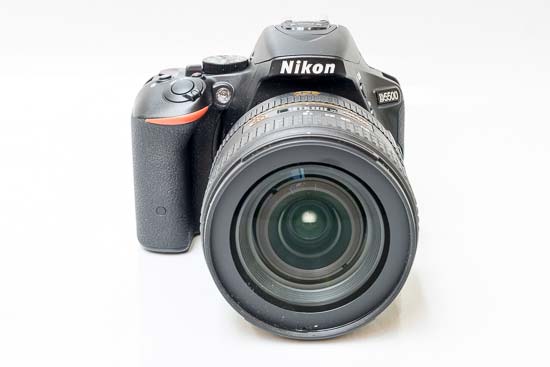 The AF-S DX Nikkor 16-80mm f/2.8-4E ED VR lens mounted on a Nikon D5500
The AF-S DX Nikkor 16-80mm f/2.8-4E ED VR lens mounted on a Nikon D5500
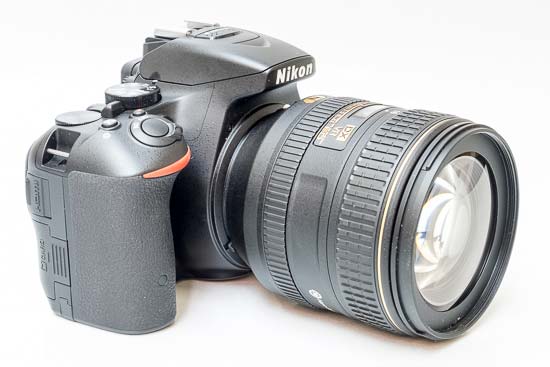 The AF-S DX Nikkor 16-80mm f/2.8-4E ED VR lens mounted on a Nikon D5500
The AF-S DX Nikkor 16-80mm f/2.8-4E ED VR lens mounted on a Nikon D5500
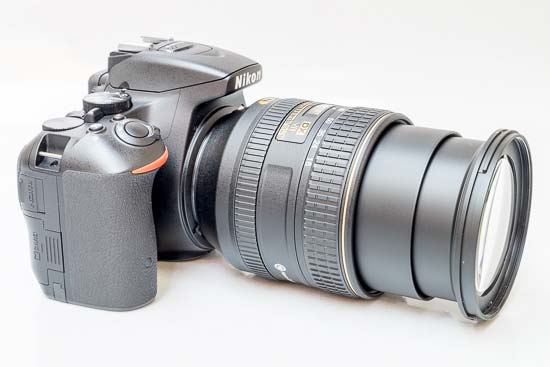 The AF-S DX Nikkor 16-80mm f/2.8-4E ED VR lens mounted on a Nikon D5500
The AF-S DX Nikkor 16-80mm f/2.8-4E ED VR lens mounted on a Nikon D5500
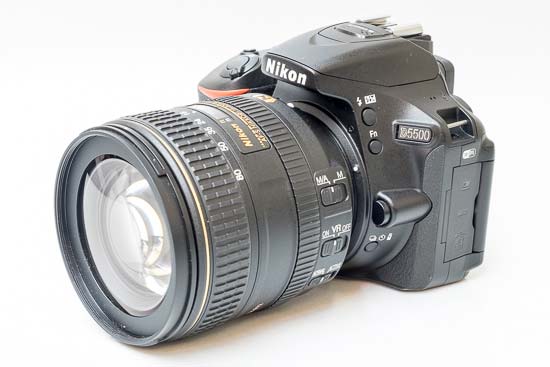 The AF-S DX Nikkor 16-80mm f/2.8-4E ED VR lens mounted on a Nikon D5500
The AF-S DX Nikkor 16-80mm f/2.8-4E ED VR lens mounted on a Nikon D5500
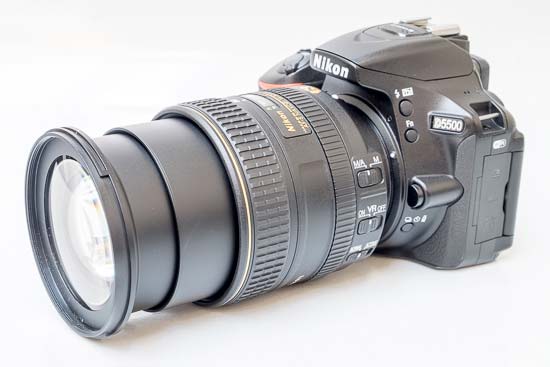 The AF-S DX Nikkor 16-80mm f/2.8-4E ED VR lens mounted on a Nikon D5500
The AF-S DX Nikkor 16-80mm f/2.8-4E ED VR lens mounted on a Nikon D5500
The build quality of the AF-S DX Nikkor 16-80mm f/2.8-4E ED VR is very good. The lens feels solid in your hand, even though the outer barrel and the 72mm filter thread are plastic. The focusing ring is wide, ridged and rubberised.
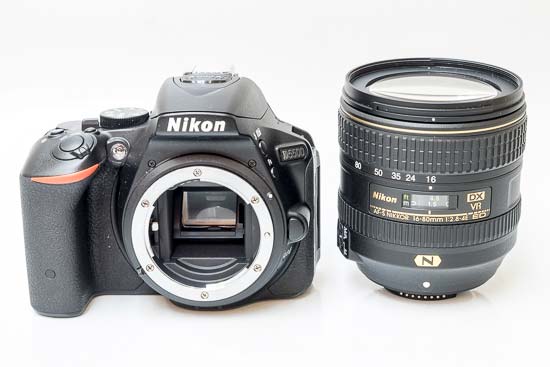 The AF-S DX Nikkor 16-80mm f/2.8-4E ED VR lens alongside a Nikon D5500
The AF-S DX Nikkor 16-80mm f/2.8-4E ED VR lens alongside a Nikon D5500
 Front of the AF-S DX Nikkor 16-80mm f/2.8-4E ED VR lens
Front of the AF-S DX Nikkor 16-80mm f/2.8-4E ED VR lens
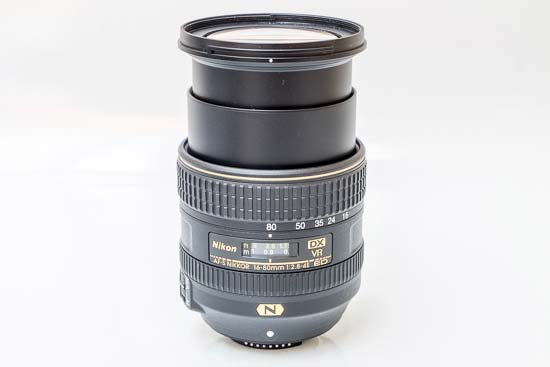 Front of the AF-S DX Nikkor 16-80mm f/2.8-4E ED VR lens, extended to 80mm
Front of the AF-S DX Nikkor 16-80mm f/2.8-4E ED VR lens, extended to 80mm
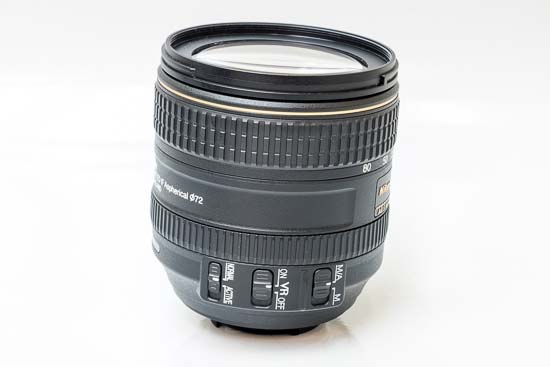 Front of the AF-S DX Nikkor 16-80mm f/2.8-4E ED VR lens
Front of the AF-S DX Nikkor 16-80mm f/2.8-4E ED VR lens
The first control on the lens barrel is a focus mode switch with A and M settings. Note that this solution does still allow for instant manual override when the focus mode switch is in the A position.
Below the focus mode selector is a similar sliding switch for the Vibration Reduction system. Nikon claims an advantage of “up to four stops” for the Vibration Reduction system employed in the AF-S DX Nikkor 16-80mm f/2.8-4E ED VR lens - and while such good results are probably the exception rather than the rule, we had no problems taking sharp hand-held shots with the lens mounted to a Nikon D5500 body at shutter speeds at least 3 stops slower than the focal length would allow. In addtition, there's a third switch for toggling between the Normal and Active VR modes, and this lens features VR with automatic tripod detection to automatically counteract vibration when mounted on a tripod.
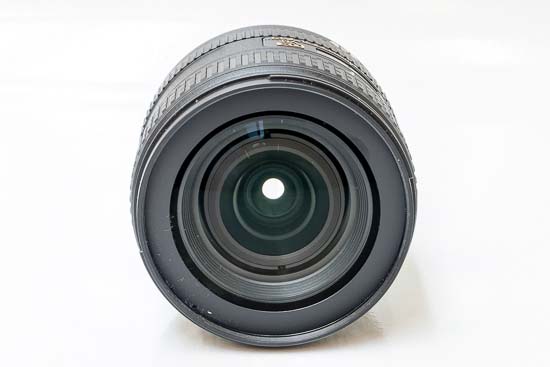 Front of the AF-S DX Nikkor 16-80mm f/2.8-4E ED VR lens
Front of the AF-S DX Nikkor 16-80mm f/2.8-4E ED VR lens
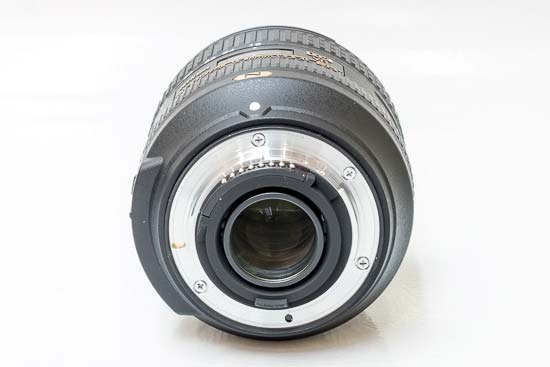 Rear of the AF-S DX Nikkor 16-80mm f/2.8-4E ED VR lens
Rear of the AF-S DX Nikkor 16-80mm f/2.8-4E ED VR lens
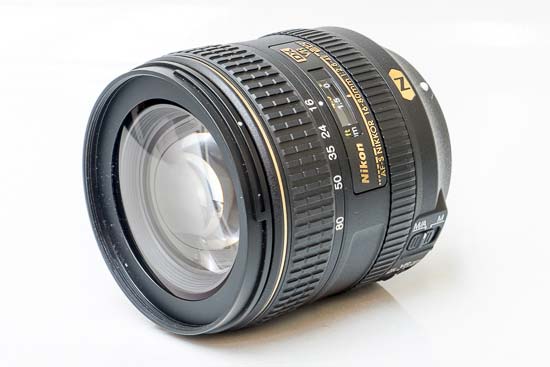 Side of the AF-S DX Nikkor 16-80mm f/2.8-4E ED VR lens
Side of the AF-S DX Nikkor 16-80mm f/2.8-4E ED VR lens
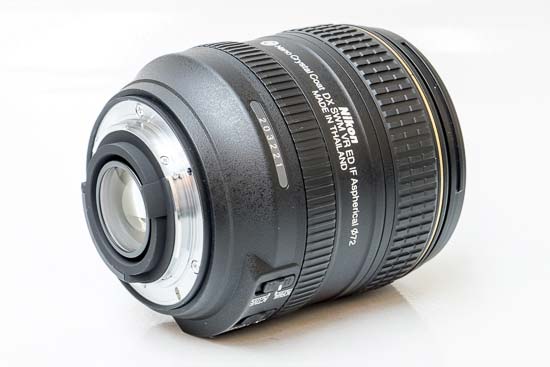 Side of the AF-S DX Nikkor 16-80mm f/2.8-4E ED VR lens
Side of the AF-S DX Nikkor 16-80mm f/2.8-4E ED VR lens
The lens mount is made of metal, rather than cheaper, less durable plastic. Note that there's no rubber gasket around the lens mount – your camera body may be weather sealed but this lens is not, so think twice before taking it to rainy or dusty locales.
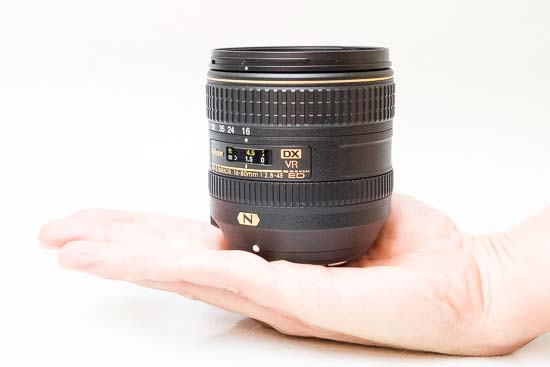 The AF-S DX Nikkor 16-80mm f/2.8-4E ED VR lens in-hand
The AF-S DX Nikkor 16-80mm f/2.8-4E ED VR lens in-hand
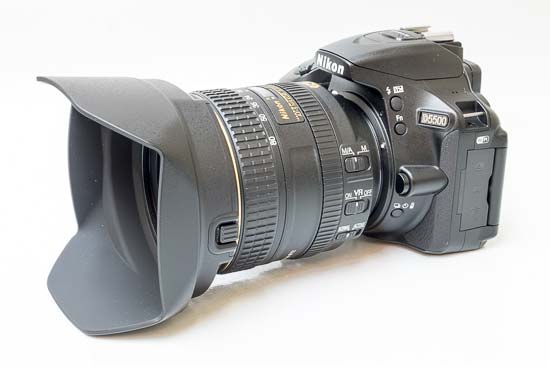 The AF-S DX Nikkor 16-80mm f/2.8-4E ED VR lens with the supplied lens hood fitted
The AF-S DX Nikkor 16-80mm f/2.8-4E ED VR lens with the supplied lens hood fitted
The AF-S DX Nikkor 16-80mm f/2.8-4E ED VR lens ships with the large dedicated HB-75 bayonet hood.
Auto-focus
The AF-S DX Nikkor 16-80mm f/2.8-4E ED VR lens features a Silent Wave Motor (SWM) that allows near-silent auto-focusing on all Nikon DSLR cameras. In use, we found the focusing to be pretty quiet and pleasingly fast - but not instantaneous - with the lens mounted to a Nikon D5500 body. It did tend to hunt for focus though when changing the focus point from close-up to much further away.
The lens barrel extends further when zoomed out to 80mm. The front of the lens does not rotate on focus, which is good news for those who use polarisers or ND grads on a regular basis.
Chromatic Aberrations
Lateral chromatic aberrations, typically seen as blue or purple fringes along contrasty edges, and longitudinal chromatic aberrations, which is green fringing evident in blurred backgrounds and magenta fringes sometimes appearing in out-of-focus foregrounds, are both well-controlled with this lens - the examples below show the worst-case scenarios.
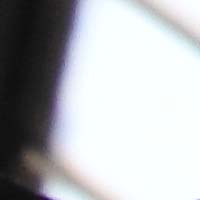 |
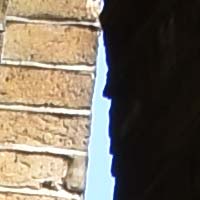 |
Flare
Nikon's Nano Crystal Coating is employed for the first time on a DX-lens, and flare is very well-controlled even when shooting directly into the sun, as in the examples below.
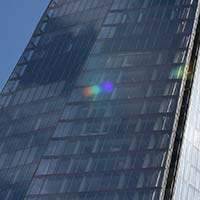 |
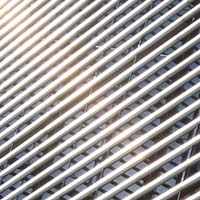 |
Light Fall-off
With the AF-S DX Nikkor 16-80mm f/2.8-4E ED VR lens wide open, you can see some heavy light fall-off in the corners and along the frame edges. Stopping down helps, although to completely get rid of this phenomenon, you will need to use an f-stop of f/5.6 or smaller. There's also some very obvious barrel distortion at 16mm and mild pincushioning at 80mm.
 Vignetting at 16mm
Vignetting at 16mm
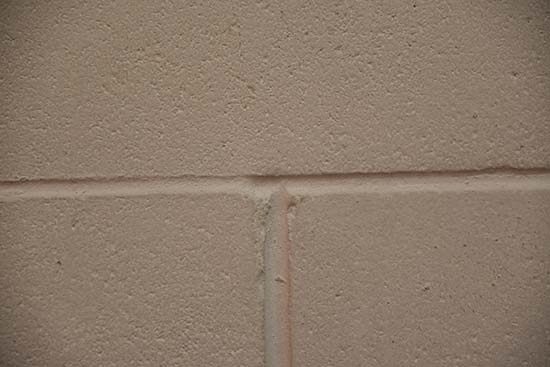 Vignetting at 80mm
Vignetting at 80mm
Macro
The AF-S DX Nikkor 16-80mm f/2.8-4E ED VR is not a macro lens, but it does deliver pretty decent close-up performance. The closest focusing distance is 0.35 m/1.15 ft throughout the entire focal range, and Nikon quotes a maximum magnification of 0.22x for the lens. The following example illustrates how close you can get to the subject at 80mm focal length, in this case a CompactFlash card.
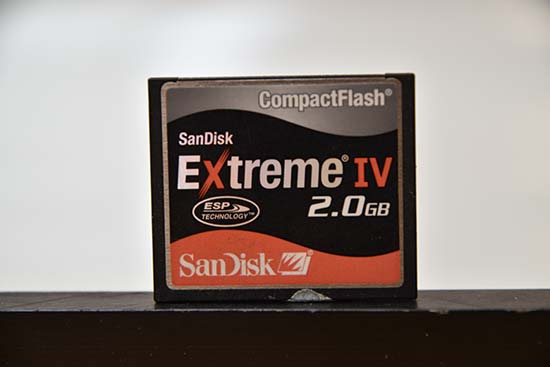 Close-up performance
Close-up performance
Bokeh
Bokeh is a word used for the out-of-focus areas of a photograph, and is usually described in qualitative terms, such as smooth / creamy / harsh etc. Nikon have employed an iris diaphragm with 7 rounded blades for a pleasing rendering of the out-of-focus highlights. Based on what we have seen, we can say that they largely succeeded. Below you'll find some examples, but you are also encouraged to check out our sample images.
 |
 |
 |
 |
Sharpness
In order to show you how sharp this lens is, we are providing 100% crops on the following pages.
-
Ease
of Use -
Sample
Images -
Lens
Specs -
Rating &
Conclusion -
Main
Rivals -
Review
Roundup - Comment
